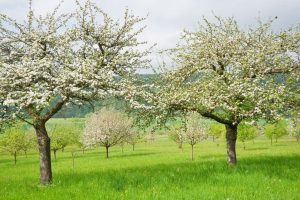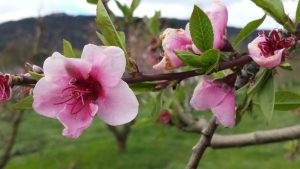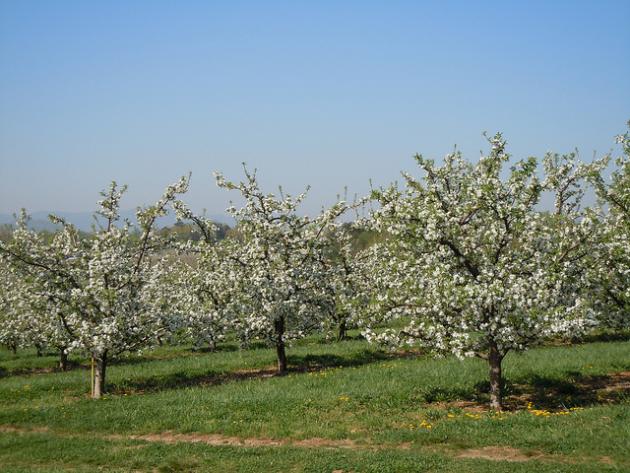When do apple trees bloom?
Apple trees (Malus domestica) are common in orchards and gardens, valued for both their fruit and their blooms. Understanding when do apple trees bloom is critical for orchard management, gardening planning, and enjoying the natural beauty they provide. In this comprehensive guide, we will look at the elements that influence apple tree bloom times, the types that bloom early or late, and how environmental factors play an important role in this annual display.
When do apple trees bloom?

Apple trees blossom in early to mid-spring, from March to May, depending on the local environment and variety. The flowering period lasts roughly 1 to 2 weeks, during which time the trees produce clusters of beautiful white or pink flowers. This stage is important for pollination because bees and other pollinators visit the blossoms to distribute pollen, which promotes fruit development. Sufficient winter chilling hours, adequate pruning, and optimal feeding all substantially impact the bloom’s timing and success. Ensuring these parameters promotes a healthy and productive apple harvest.
How long do apple trees blossom?
Apple trees typically flower for 1 to 2 weeks, depending on environmental circumstances and the tree’s kind. After a significant number of cold hours in the winter, the bloom period typically occurs in early to mid-spring. During this time, apple trees produce gorgeous clusters of blooms ranging in color from white to pink, attracting pollinators such as bees. The duration of blooming is critical for proper pollination and subsequent fruit development, making it an important stage in apple trees’ annual growth cycle.
Why do apple trees need cold weather to bloom?
Apple trees require cold temperatures to bloom due to a process known as vernalization, which is necessary for their reproductive cycle. Vernalization is the prolonged exposure of plants to cold temperatures, typically throughout the winter. This cold period is critical for apple trees because it breaks dormancy and stimulates buds to develop in the spring.

During the winter, cold temperatures cause physiological changes within the tree, such as the buildup of certain chemicals and the alteration of gene expression. This procedure guarantees that the buds are ready to expand quickly and bloom when warmer temperatures arrive in spring. Without sufficient cooling hours, apple trees may struggle to break dormancy, resulting in delayed or uneven bloom patterns that can have a substantial influence on fruit yield.
In essence, cold weather serves as a natural cue for apple trees, signaling the end of winter and the start of the bloom season, ensuring successful reproduction and fruit production.
How to Identify Flower Buds on Apple Trees
Identifying flower buds on apple trees allows orchardists and gardeners to forecast bloom seasons and plan accordingly. The size, shape, and position of flower buds on apple trees differ from leaf buds on the tree. Flower buds are usually larger and more rounded than leaf buds, especially in late winter and early spring when they start to swell in preparation for flowering.
One useful approach to identifying flower buds is to examine the tree’s bud arrangement carefully. Flower buds frequently cluster in spurs along branches, making them appear denser than leaf buds, which are more evenly distributed. Furthermore, studying the buds under a magnifying glass might reveal minute changes in shape and structure between flower and leaf buds.
Why Your Apple Tree Isn’t Blooming
Your apple tree may not be blossoming for a variety of reasons related to its reproductive cycle. Understanding these variables can aid in diagnosing and addressing the problem.
Young Age: Apple trees often require several years to grow before producing flowers. Young trees focus on developing strong root systems and may not devote enough energy to flowering at first.
Chilling Requirement: Insufficient chilling hours throughout the winter can cause buds to develop late or not at all. Apple trees require a specific amount of cold weather to break dormancy and begin blooming in the spring.
Trimming Techniques: Improper trimming, such as excessive or inappropriate timing, might eliminate potential blossoming buds or disturb the tree’s growth cycle. Pruning during the dormant season is essential for shaping the tree and increasing flowering.
Nutrient Deficiency: Poor soil nutrition, particularly shortages in phosphate and potassium, can prevent floral bud production. Soil tests can help detect and fix nutrient imbalances.
Environmental Stress: Extreme weather conditions, such as late frosts or extended dryness, can harm buds or alter the bloom cycle. Providing appropriate water and frost protection can help to mitigate these dangers.
Pollination Issues: Poor fruit set despite flowering can result from inadequate pollination due to a lack of pollinators or incompatible kinds planted close together.
Related Posts:
How can I make my apple tree bloom?
By following these important measures, encourage your apple tree to bloom and maximise flower production.
Provide Adequate Chilling Hours: Ensure that your apple tree gets enough cold weather during the winter. Most apple types require chilling (usually 800-1000 hours below 45°F or 7°C) to break dormancy and stimulate bud growth for spring blooming.
Choose the Right Variety: If you are planting numerous apple trees, choose types that are suited to your environment and have compatible pollination requirements. Some types bloom more consistently than others, so look into local recommendations or call a nursery.
Pruning regularly and properly during the dormant season (late winter to early spring) benefits tree health, improves air circulation, and stimulates new growth and flowering. Remove any dead, damaged, or crossed branches to promote the formation of fruiting spurs, where blossoms develop.
Optimal Nutrition: Ensure that the apple tree receives enough nutrients, particularly nitrogen, phosphorus, and potassium. Perform a soil test to identify deficiencies, and then apply appropriate fertilizers or organic amendments to promote healthy development and blooming.
Water consistently: Keep the soil moist, especially during dry spells. Adequate water intake is essential for bud growth and flower creation. Mulching around a tree’s base can help conserve moisture and regulate soil temperature.
Manage Pests and Diseases: Keep an eye out for pests and diseases on your apple tree, because they can influence blossoming and general tree health. To reduce tree damage and stress, use appropriate cultural practices or organic treatments.
Pollinator: Encourage pollinator activity by planting bee-friendly flowers nearby and refraining from using pesticides during bloom. Cross-pollination between different apple varieties can improve fruit sets, so consider planting suitable pollinators if needed.
FAQs
What factors affect apple tree blooming dates?
The main factors determining apple tree bloom times are as follows:
To break dormancy and bloom in the spring, apple trees require a specific level of cold temperatures in the winter.
Higher temperatures in early spring are required for bud growth and blooming.
Apple types have different bloom times. Some flowers bloom early in the season, while others bloom later.
Why is bloom time critical for apple tree growers?
Bloom time is crucial for apple tree growers because it signals the beginning of the fruiting cycle. Proper timing ensures proper pollination and subsequent fruit set, which influences the quality and quantity of the harvest.
Can I extend my apple tree’s bloom time?
While you cannot greatly lengthen apple trees’ natural bloom span, choosing a variety with staggered bloom timings can help extend your orchard’s total flowering season. Furthermore, maintaining ideal tree health through proper care techniques can extend and improve the bloom’s duration and quality.
Should I prune my apple tree when it is in bloom?
Pruning apple trees while they are in bloom is generally not recommended. Pruning during the dormant season (late winter to early spring) is most effective for shaping the tree and stimulating fruiting spurs. Pruning during bloom might impair the pollination process and limit fruit yield.
Conclusion
Knowing when do apple trees bloom is critical for anybody interested in orchard management, gardening, or simply admiring nature’s beauty. Growers can optimise bloom timing and increase fruit yield by considering climate, apple type, pruning procedures, and environmental factors.




